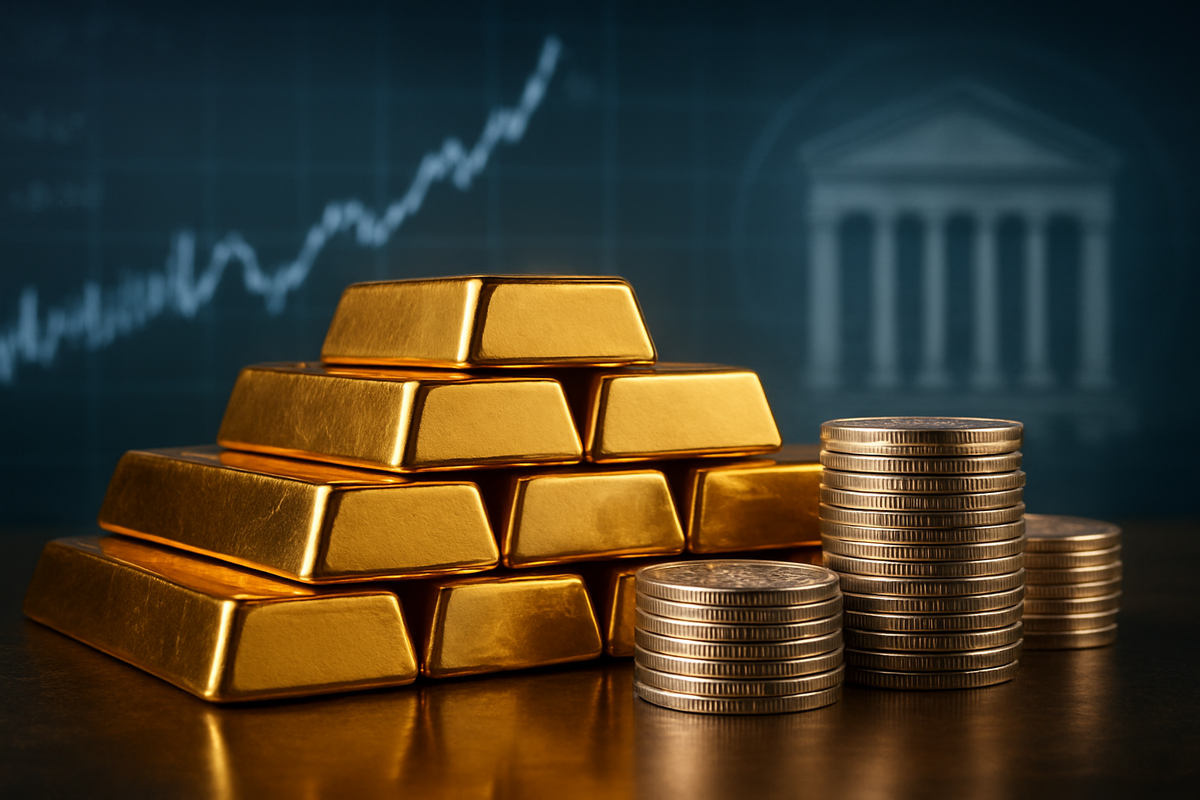
Late 2025 has seen the precious metals market ignite, with spot gold charting its fourth consecutive monthly gain and spot silver rocketing to a fresh all-time record high. This remarkable ascent is primarily fueled by escalating expectations of a Federal Reserve interest rate cut, signaling a significant shift in monetary policy that is reverberating across global financial markets and re-emphasizing the role of precious metals as a crucial hedge against economic uncertainty and inflation.
As of November 28, 2025, spot gold is trading robustly around $4,160 to $4,171 per ounce, having already touched an all-time high of $4,381.58 in October. This consistent upward trajectory positions gold for what analysts believe could be its strongest annual performance since 1979, with year-to-date gains hovering between 58% and 60%. Silver's rally has been even more explosive in percentage terms, soaring past $55 per ounce to reach new all-time highs in London trade, just shy of its October 17 record of $54.50. Silver boasts an impressive year-to-date gain exceeding 81%, outperforming gold and indicating a powerful underlying demand.
A Deep Dive into the Precious Metals Phenomenon
The current rally in gold and silver is a multi-faceted event, deeply intertwined with global economic sentiment and central bank policy. The most significant driving force is the market's conviction that the Federal Reserve is on the cusp of easing its monetary policy. As of late November 2025, market traders are assigning a high probability, between 80% and 87%, to a 25-basis-point rate cut by the Federal Reserve in December. This represents a sharp increase in dovish expectations compared to earlier in the month, with further cuts anticipated into 2026.
This dovish shift by the Fed is underpinned by several key factors. A series of softer U.S. labor market readings, including falling job openings and weak wage growth, alongside cooling U.S. economic data, have strengthened the argument for monetary easing. Remarks from senior Federal Reserve officials, such as Governor Christopher Waller and New York Fed President John Williams, have also signaled the central bank's readiness to potentially ease monetary policy. Lower interest rates inherently reduce the opportunity cost of holding non-yielding assets like gold and silver, making them more attractive to investors seeking returns outside of traditional interest-bearing instruments. Furthermore, lower interest rate expectations typically lead to a weaker U.S. dollar, which, in turn, makes dollar-denominated precious metals more affordable and appealing to international buyers, thereby boosting demand.
Beyond the Fed's influence, other factors are bolstering the precious metals market. Persistent inflation, still above comfortable levels for central banks, continues to fuel demand for gold as a traditional hedge against eroding purchasing power. Geopolitical uncertainties, ranging from ongoing conflicts to broader global instability, consistently drive investors towards safe-haven assets. Central banks, particularly in emerging markets, have been robust buyers of gold, diversifying their reserves away from the U.S. dollar. For silver, robust industrial demand, especially from the burgeoning solar panel manufacturing and electric vehicle sectors, coupled with projected supply deficits for both 2024 and 2025 and China's silver inventories dropping to a decade low, indicates a potential supply crunch that is further supporting its price surge.
Initial market reactions have been overwhelmingly positive, with significant inflows into gold and silver-backed Exchange Traded Funds (ETFs) and a generally bullish sentiment among analysts. Many believe gold is poised for its strongest annual rally in decades, while UBS has raised its silver price forecasts, anticipating the metal to trade at $60 an ounce in 2026, with some more ambitious analysts even predicting $100 or $130 per ounce in the extended future.
Companies Poised to Win or Lose in the Precious Metals Boom
The sustained rally in gold and silver prices is creating a clear distinction between winners and those facing increased operational costs across various industries. Mining companies that extract these precious metals are the most direct beneficiaries, experiencing a significant boost to their revenues, profitability, and stock performance.
The Winners:
Gold and silver mining companies see their profit margins expand dramatically as metal prices rise while many of their operational costs remain relatively fixed. This operational leverage means a percentage increase in metal prices can translate into a much larger percentage increase in net profit. Higher prices also incentivize increased exploration, development of new projects, and strategic acquisitions.
- Gold Mining Companies:
- Newmont Corporation (NYSE: NEM): As the world's largest gold mining business, Newmont is exceptionally well-positioned to capitalize on sustained high gold prices.
- Barrick Gold Corporation (NYSE: GOLD): A top-tier gold miner, Barrick benefits from powerful margin expansion when gold prices are above $4,000 per ounce.
- Agnico Eagle Mines Limited (NYSE: AEM): Known for operational excellence and stable asset bases, Agnico Eagle's profitability is enhanced by rising prices.
- Alamos Gold Inc. (NYSE: AGI / TSX: AGI): Has demonstrated strong operating leverage, with earnings growing significantly faster than revenue due to rising gold prices.
- Kinross Gold Corporation (NYSE: KGC / TSX: K) and Centerra Gold (TSX: CG / NYSE: CGAU) are also poised for strong performance.
- Silver Mining Companies:
- Pan American Silver Corp. (NASDAQ: PAAS / TSX: PAAS): One of the world's largest primary silver producers, benefiting from both rising prices and declining All-in Sustaining Costs (AISC).
- First Majestic Silver Corp. (NYSE: AG / TSX: AG): A pure-play silver miner highly leveraged to rising silver prices.
- Fresnillo plc (LSE: FRES): The world's largest primary silver producer, known for extensive reserves and low production costs.
- Hecla Mining Company (NYSE: HL), Silvercorp Metals Inc. (NYSE MKT: SVM), and Vizsla Silver Corp. (TSX: VZLA / NYSEAMERICAN: VZLA) are also strong contenders.
- Royalty and Streaming Companies: These companies provide upfront capital to miners in exchange for future revenue percentages or physical metal production at a set price, offering lower operational risk and direct leverage to commodity prices.
- Wheaton Precious Metals Corp. (NYSE: WPM / TSX: WPM): A dominant player in both gold and silver streaming.
- Franco-Nevada Corporation (NYSE: FNV / TSX: FNV): The largest and most diversified precious metals royalty and streaming company.
- Royal Gold, Inc. (NASDAQ: RGLD) and Osisko Gold Royalties Ltd. (NYSE: OR / TSX: OR) are also key beneficiaries.
Potential Losers (or those negatively impacted):
While direct producers flourish, industries heavily reliant on gold and silver as raw materials may face increased input costs, potentially squeezing profit margins if these costs cannot be passed on to consumers.
- Industrial Users:
- Electronics Manufacturers: Silver's superior electrical conductivity makes it critical for electronics; higher prices could impact companies in this sector.
- Solar Panel Manufacturers (Photovoltaics): Silver is a key component in solar cells. Companies like First Solar, Inc. (NASDAQ: FSLR) could face increased material costs.
- Jewelry Manufacturers: Higher gold and silver prices directly increase their material costs, potentially impacting consumer demand.
- Inefficient Mining Operations: Even in a high-price environment, mining companies with high All-in Sustaining Costs (AISC) or significant debt may struggle to fully capitalize on the rally, seeing relatively smaller gains compared to more efficient peers.
Wider Significance and Historical Context
The late 2025 rally in gold and silver signifies more than just a fleeting market trend; it points to deeper structural shifts in the global financial landscape. This surge underscores gold's enduring role as a safe-haven asset amidst persistent global economic uncertainties, escalating geopolitical tensions, and a strategic pivot by central banks away from dollar-denominated reserves. Silver's outperformance further highlights its dual nature as both a monetary metal and a critical industrial commodity, especially with the accelerating green energy transition.
The anticipated Federal Reserve interest rate cuts are a primary catalyst, reducing the opportunity cost of holding non-yielding assets and weakening the U.S. dollar, thereby making precious metals more attractive. This dynamic fits into a broader trend of "de-dollarization" as central banks, particularly in emerging markets, diversify their reserves. The persistent supply deficits, especially for silver, coupled with robust investment flows into precious metals ETFs, indicate a strong underlying demand that mining production is struggling to meet.
Historically, the current environment draws parallels to the inflationary periods of the 1970s and early 1980s, when gold prices soared amidst economic turmoil. Similar patterns of flight to safety were observed during the post-2008 financial crisis and the COVID-19 pandemic. Silver's tendency to outperform gold during precious metals bull markets, due to its smaller market size and dual demand characteristics, is also a recurring theme, echoing its performance in the 1970-1980 and 2001-2011 bull markets. The current multi-year supply deficit in silver is particularly reminiscent of periods where structural pressures, rather than speculative frenzies, drive prices.
Ripple effects extend beyond the precious metals sector. Traditional financial assets, especially those sensitive to interest rate hikes or equity market volatility, may see capital reallocated towards tangible assets. A weaker U.S. dollar diminishes its appeal as a safe haven, further redirecting capital towards gold and silver. For mining companies, this bullish market translates into increased business opportunities for exploration firms, equipment manufacturers, and logistics providers. However, for industries heavily reliant on silver as an input, increased costs could accelerate the adoption of alternative materials or push manufacturers to explore new supply chain strategies. Regulatory discussions around tariffs on imported gold or silver, and environmental regulations on mining operations, could also gain traction.
What Comes Next: Navigating the Precious Metals Landscape
The outlook for gold and silver from late 2025 into 2026 and beyond appears broadly bullish, suggesting a structural bull market is firmly in place. Short-term, the market will remain highly sensitive to Federal Reserve policy. JPMorgan anticipates further 25-basis-point cuts in both December 2025 and January 2026, which would continue to reduce the opportunity cost of holding precious metals and potentially weaken the dollar further.
Major banks and analysts are projecting significant upside for both metals. Deutsche Bank forecasts an average gold price of US$4,450 per ounce in 2026, with Goldman Sachs expecting it to reach US$4,900, and Bank of America even suggesting a potential high of US$5,000 per ounce in 2026. For silver, UBS anticipates it could reach US$60 per ounce in 2026, with some forecasts suggesting it could break above US$60 in mid-to-late 2026.
Long-term, the bullish trend is supported by persistent policy uncertainty, ongoing fiscal challenges, and elevated geopolitical risks. Central banks are expected to remain significant gold buyers, continuing their diversification away from U.S. dollar reserves. The stablecoin sector, particularly Tether, has also emerged as a new structural driver for gold demand. Silver's industrial demand is projected to strengthen further, driven by the expanding green energy sector. Supply constraints for both metals are likely to persist, providing a fundamental floor for prices.
For market participants, strategic pivots are becoming essential. Diversification into precious metals is increasingly viewed as crucial portfolio insurance against monetary instability, inflation, and currency debasement. Systematic accumulation, rather than short-term timing, is recommended given the structural drivers. Some experts suggest a tactical favor towards precious metal miners and silver, as mining equities offer greater leverage to metal prices, and silver provides a more affordable alternative with significant upside potential. Close monitoring of Fed communications, inflation rates, and real interest rates will be paramount.
Potential scenarios range from a continued bullish trend, fueled by ongoing volatility and Fed easing, to an accelerated bullish scenario driven by heightened geopolitical tensions or stronger-than-expected industrial demand for silver. A more hawkish shift by central banks, a stronger U.S. dollar, or a significant easing of geopolitical tensions could, however, lead to stalled momentum or a market correction.
Comprehensive Wrap-up: A New Era for Precious Metals
The late 2025 rally in gold and silver is a defining moment for the precious metals market, signaling a robust bull phase driven by a confluence of monetary policy expectations, geopolitical factors, and fundamental supply-demand dynamics. Gold's consistent monthly gains and silver's record-breaking highs underscore their enduring significance as vital components of a diversified investment portfolio, reaffirming their roles as reliable hedges against inflation and economic uncertainty.
This trend highlights a notable shift in investor sentiment, with a growing preference for tangible assets amidst persistent global risks and a more accommodative monetary policy environment. Silver's outstanding performance, in particular, emphasizes its unique position. Its dual functionality as both a safe-haven asset and a critical industrial commodity amplifies its price movements, potentially offering superior returns during periods where robust industrial demand coincides with broader monetary system stress.
Moving forward, the market appears poised for continued strength, especially with the anticipated Federal Reserve interest rate cuts reducing the opportunity cost of holding these non-yielding assets. Investors should remain vigilant and closely monitor several key indicators in the coming months: the timing and magnitude of future Federal Reserve interest rate decisions, persistent inflation data, evolving geopolitical landscapes, U.S. dollar strength, and the intricate supply and demand dynamics for both gold and silver, particularly industrial demand for the latter. Central bank reserve activities and ETF flows will also provide crucial insights into broader market sentiment.
In essence, the gold and silver markets are not just experiencing a temporary surge but are undergoing a significant re-evaluation of their role in the global financial system. This new era for precious metals demands careful attention and strategic adaptation from investors seeking to navigate an increasingly complex and uncertain economic future.
This content is intended for informational purposes only and is not financial advice.








